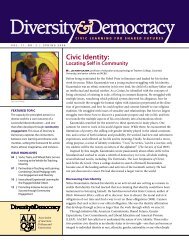From High School to the Future: Potholes on the ... - DiversityWeb
From High School to the Future: Potholes on the ... - DiversityWeb
From High School to the Future: Potholes on the ... - DiversityWeb
Create successful ePaper yourself
Turn your PDF publications into a flip-book with our unique Google optimized e-Paper software.
• students of all levels of qualificati<strong>on</strong>s have difficulty<br />
taking <str<strong>on</strong>g>the</str<strong>on</strong>g> steps <str<strong>on</strong>g>to</str<strong>on</strong>g> enroll in a four-year college.<br />
Students who aspired <str<strong>on</strong>g>to</str<strong>on</strong>g> attain a four-year degree<br />
and graduated with low GPAs and ACT scores,<br />
and thus very limited access <str<strong>on</strong>g>to</str<strong>on</strong>g> college, were<br />
unlikely <str<strong>on</strong>g>to</str<strong>on</strong>g> plan <str<strong>on</strong>g>to</str<strong>on</strong>g> attend, apply <str<strong>on</strong>g>to</str<strong>on</strong>g>, or be accepted<br />
<str<strong>on</strong>g>to</str<strong>on</strong>g> four-year colleges. However, many of <str<strong>on</strong>g>the</str<strong>on</strong>g> more<br />
qualified students did not c<strong>on</strong>sider attending a<br />
four-year college, and even some who planned <str<strong>on</strong>g>to</str<strong>on</strong>g><br />
attend did not apply. Only 73 percent of students<br />
qualified <str<strong>on</strong>g>to</str<strong>on</strong>g> attend a somewhat selective college<br />
(<str<strong>on</strong>g>the</str<strong>on</strong>g> majority of four-year colleges in Illinois)<br />
expected <str<strong>on</strong>g>to</str<strong>on</strong>g> attend a four-year college in <str<strong>on</strong>g>the</str<strong>on</strong>g> fall,<br />
and <strong>on</strong>ly 61 percent applied. Similarly, <strong>on</strong>ly 76<br />
percent of students qualified <str<strong>on</strong>g>to</str<strong>on</strong>g> attend a selective<br />
four-year college applied <str<strong>on</strong>g>to</str<strong>on</strong>g> a four-year college,<br />
even though students with access <str<strong>on</strong>g>to</str<strong>on</strong>g> a selective<br />
four-year college were accepted at very high rates<br />
when <str<strong>on</strong>g>the</str<strong>on</strong>g>y applied.<br />
• Latino students have <str<strong>on</strong>g>the</str<strong>on</strong>g> most difficulty managing<br />
college enrollment.<br />
Latino students were <str<strong>on</strong>g>the</str<strong>on</strong>g> least likely <str<strong>on</strong>g>to</str<strong>on</strong>g> plan <str<strong>on</strong>g>to</str<strong>on</strong>g><br />
enroll in a four-year college after graduati<strong>on</strong> and<br />
<str<strong>on</strong>g>the</str<strong>on</strong>g> least likely <str<strong>on</strong>g>to</str<strong>on</strong>g> apply <str<strong>on</strong>g>to</str<strong>on</strong>g> a four-year college. Only<br />
60 percent of Latino graduates who aspired <str<strong>on</strong>g>to</str<strong>on</strong>g><br />
attain a four-year degree planned <str<strong>on</strong>g>to</str<strong>on</strong>g> attend a four-<br />
year college in <str<strong>on</strong>g>the</str<strong>on</strong>g> fall, compared <str<strong>on</strong>g>to</str<strong>on</strong>g> 77 percent of<br />
African-American and 76 percent of White/O<str<strong>on</strong>g>the</str<strong>on</strong>g>r<br />
Ethnic graduates. Fewer than half of Latino students<br />
who aspired <str<strong>on</strong>g>to</str<strong>on</strong>g> a four-year degree applied <str<strong>on</strong>g>to</str<strong>on</strong>g> a<br />
four-year college, compared <str<strong>on</strong>g>to</str<strong>on</strong>g> about 65 percent<br />
of <str<strong>on</strong>g>the</str<strong>on</strong>g>ir African-American and White/O<str<strong>on</strong>g>the</str<strong>on</strong>g>r<br />
Ethnic counterparts. One comm<strong>on</strong> explanati<strong>on</strong><br />
for why Latino CPS students do not enroll in<br />
four-year colleges is that <str<strong>on</strong>g>the</str<strong>on</strong>g>y are immigrants.<br />
However, we found that immigrant status does<br />
not fully explain <str<strong>on</strong>g>the</str<strong>on</strong>g> gap in college enrollment<br />
between Latino and o<str<strong>on</strong>g>the</str<strong>on</strong>g>r students; after c<strong>on</strong>trolling<br />
for immigrant status, qualificati<strong>on</strong>s, and<br />
o<str<strong>on</strong>g>the</str<strong>on</strong>g>r student characteristics, Latino students are<br />
still 13 percentage points less likely <str<strong>on</strong>g>to</str<strong>on</strong>g> enroll in a<br />
four-year college than African-American students.<br />
4 <str<strong>on</strong>g>From</str<strong>on</strong>g> <str<strong>on</strong>g>High</str<strong>on</strong>g> <str<strong>on</strong>g>School</str<strong>on</strong>g> <str<strong>on</strong>g>to</str<strong>on</strong>g> <str<strong>on</strong>g>the</str<strong>on</strong>g> <str<strong>on</strong>g>Future</str<strong>on</strong>g>: <str<strong>on</strong>g>Potholes</str<strong>on</strong>g> <strong>on</strong> <str<strong>on</strong>g>the</str<strong>on</strong>g> Road <str<strong>on</strong>g>to</str<strong>on</strong>g> College<br />
2. Attending a high school with a str<strong>on</strong>g collegegoing<br />
culture shapes students’ participati<strong>on</strong> in <str<strong>on</strong>g>the</str<strong>on</strong>g><br />
college applicati<strong>on</strong> process.<br />
Across all our analyses, <str<strong>on</strong>g>the</str<strong>on</strong>g> single most c<strong>on</strong>sistent predic<str<strong>on</strong>g>to</str<strong>on</strong>g>r<br />
of whe<str<strong>on</strong>g>the</str<strong>on</strong>g>r students <str<strong>on</strong>g>to</str<strong>on</strong>g>ok steps <str<strong>on</strong>g>to</str<strong>on</strong>g>ward college<br />
enrollment was whe<str<strong>on</strong>g>the</str<strong>on</strong>g>r <str<strong>on</strong>g>the</str<strong>on</strong>g>ir teachers reported that<br />
<str<strong>on</strong>g>the</str<strong>on</strong>g>ir high school had a str<strong>on</strong>g college climate, that<br />
is, <str<strong>on</strong>g>the</str<strong>on</strong>g>y and <str<strong>on</strong>g>the</str<strong>on</strong>g>ir colleagues pushed students <str<strong>on</strong>g>to</str<strong>on</strong>g> go<br />
<str<strong>on</strong>g>to</str<strong>on</strong>g> college, worked <str<strong>on</strong>g>to</str<strong>on</strong>g> ensure that students would be<br />
prepared, and were involved in supporting students in<br />
completing <str<strong>on</strong>g>the</str<strong>on</strong>g>ir college applicati<strong>on</strong>s. Indeed, students<br />
who attended high schools in which teachers reported<br />
a str<strong>on</strong>g college climate were significantly more likely<br />
<str<strong>on</strong>g>to</str<strong>on</strong>g> plan <str<strong>on</strong>g>to</str<strong>on</strong>g> attend a four-year school, apply, be accepted,<br />
and enroll. Importantly, having a str<strong>on</strong>g college climate<br />
seemed <str<strong>on</strong>g>to</str<strong>on</strong>g> make <str<strong>on</strong>g>the</str<strong>on</strong>g> biggest difference for students<br />
with lower levels of qualificati<strong>on</strong>s. In additi<strong>on</strong>, <str<strong>on</strong>g>the</str<strong>on</strong>g><br />
college plans and behaviors of Latino students in CPS<br />
are particularly shaped by <str<strong>on</strong>g>the</str<strong>on</strong>g> expectati<strong>on</strong>s of <str<strong>on</strong>g>the</str<strong>on</strong>g>ir<br />
teachers and counselors and by c<strong>on</strong>necti<strong>on</strong>s with<br />
teachers. This suggests that Latino students may be<br />
much more reliant than o<str<strong>on</strong>g>the</str<strong>on</strong>g>r students <strong>on</strong> teachers<br />
and <str<strong>on</strong>g>the</str<strong>on</strong>g>ir school for guidance and informati<strong>on</strong>, and<br />
that <str<strong>on</strong>g>the</str<strong>on</strong>g>ir college plans are more dependent <strong>on</strong> <str<strong>on</strong>g>the</str<strong>on</strong>g>ir<br />
c<strong>on</strong>necti<strong>on</strong>s <str<strong>on</strong>g>to</str<strong>on</strong>g> school.<br />
3. Filing a FAFsA and applying <str<strong>on</strong>g>to</str<strong>on</strong>g> multiple colleges<br />
shape students’ likelihood of being accepted <str<strong>on</strong>g>to</str<strong>on</strong>g> and<br />
enrolling in a four-year college.<br />
Applying for financial aid is not easy, but it may be<br />
<str<strong>on</strong>g>the</str<strong>on</strong>g> most critical step for low-income students <strong>on</strong> <str<strong>on</strong>g>the</str<strong>on</strong>g><br />
road <str<strong>on</strong>g>to</str<strong>on</strong>g> college. It is also <strong>on</strong>e of <str<strong>on</strong>g>the</str<strong>on</strong>g> most c<strong>on</strong>fusing<br />
steps, and it is a point at which many CPS students<br />
stumble. Our analysis finds, moreover, that many CPS<br />
students may end up facing higher costs for college<br />
because <str<strong>on</strong>g>the</str<strong>on</strong>g>y do not take <str<strong>on</strong>g>the</str<strong>on</strong>g> step of filing a Free<br />
Applicati<strong>on</strong> for Federal Student Aid (FAFSA), which<br />
is needed <str<strong>on</strong>g>to</str<strong>on</strong>g> maximize federal, state, and instituti<strong>on</strong>al<br />
support. In additi<strong>on</strong>, CPS has set <str<strong>on</strong>g>the</str<strong>on</strong>g> goal that students<br />
should apply <str<strong>on</strong>g>to</str<strong>on</strong>g> at least five colleges <str<strong>on</strong>g>to</str<strong>on</strong>g> maximize <str<strong>on</strong>g>the</str<strong>on</strong>g>ir<br />
opti<strong>on</strong>s. Our analysis supports this approach.




